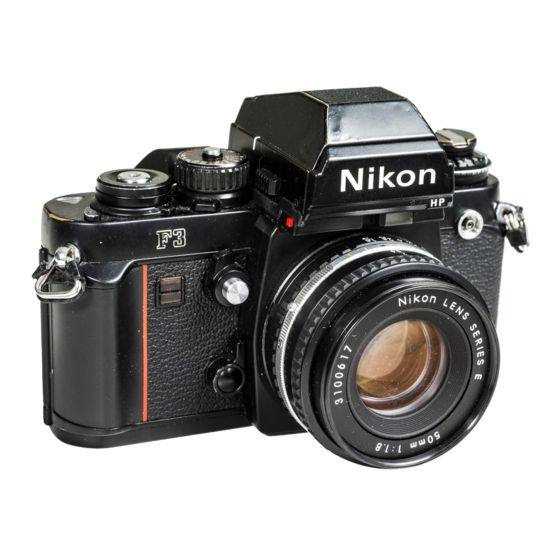Nikon 1691 - F 3HP SLR Camera Manuale di istruzioni - Pagina 24
Sfoglia online o scarica il pdf Manuale di istruzioni per Fotocamera digitale Nikon 1691 - F 3HP SLR Camera. Nikon 1691 - F 3HP SLR Camera 47.

-CONTROLS IN DETAIL-continued----------
24
Multiple exposure lever
@l
Double
or
multiple
exposures
are
easy to
accomplish with
the F3's
multiple exposure lever.
Follow this procedure
:
1.
Take
the first shot.
2.
Then to
recoc
k
the
shutter without advancing the film,
push the multiple
exposure
lever forward (Fig
.
1),
and
stroke
the advance
lever. Immediately the multiple
exposure lever will spring back to its normal position
(Fig
.
2).
3
.
Now you're ready to take the second shot on the same
frame
.
For more than two shots
on
the same frame
,
just
repeat the same procedure for
each
additional
ex-
posure. When
you've
finished,
simply advance
the film
normally to the next frame
.
Note:
While making multiple
exposures,
the frame
counter
doesn't
advance.
Batteries
When
battery power
fails,
the camera's
exposure
meter
stops
working
and
the
shutter won't work either unless
you use the backup mechanical
release lever.
For this
reason, it is a good idea to carry an
extra
set
of
batteries
with you whenever you set out to take pictures.
Under
normal usage, one set of 1.5V silver-oxide
batteries (Eveready EPX76 or
equivalent)
will last for
about one year. Try not
to
touch the
+
or
-
surfaces of
the
batteries as
this
many result in poor
e lectrical contact.
If
you do get fingerprints on the battery terminals, wipe
them
off
with a soft cloth.
At
below-freezing temperatures, battery performance
deteriorates.
The
use of a fresh set
of
batteries
is
recom-
mended
to ensure reliable service at low temperatures.
In
extremely cold climates, it
is
recommended
to use the
F3
in
conjunction
with the MD-4 Motor Drive
.
With the
motor drive attached, the
camera
gets
all
its power from
the
batteries in
the motor drive.
Thus,
if you use a NiCd
battery
,
the camera/motor
drive will operate down
to
-20°C.
Note:
At
-10°C
or
below,
the
LCD
may exhibit a
slight
delay in
response
time.
This
is
natural and
should
be
no couse
for
concern.
However,
exposure to
extremely high
temperatures
(BO°C and above) may
actually
shorten the
life
of
the LCD.
